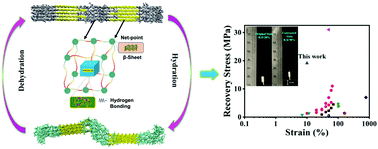Artificial spider silk is smart like natural one: having humidity-sensitive shape memory with superior recovery stress
Abstract
Spider dragline silk features supercontraction with great sensitivity to humidity/water. Enlightened by this phenomenon, we here put forward an understanding of spider silk supercontraction as a shape memory behaviour and for the first time realised this behaviour with our genetically engineered major ampullate spidroin 2 (eMaSp2) fibre, which has abundant polyalanine and proline motifs. Interestingly, at 75% relative humidity (RH), the eMaSp2 fibre demonstrated humidity-triggered shape memory behaviour with good shape fixity of 82.1 ± 2.1% and a total recovery ratio of 98.5 ± 0.4%. Apart from that, eMaSp2 fibre displayed a recovery stress of 18.5 ± 0.5 MPa at 90% RH, outperforming almost all shape memory polymers and even most shape memory composites reported to date. Evidenced by the results, β-sheets within the artificial silk fibre acted as netpoints and hydrogen bonds (HB) were designated as switches in the amorphous region (consisting of α-helix, β-turn and random coil), collectively making a typical shape memory model. To further support this shape memory model, eMaSp2 was evaluated by using an equilibrated molecular dynamics (EQMD) simulation for 200 ns. Under various hydration levels, the change of the HB in the crystalline and amorphous regions not only demonstrated the contraction mechanism but also proved the shape memory theory. This study shows that the eMaSp2 fibre is a humidity-sensitive shape memory material, providing new insight into smart behaviours presented by artificial spider silks.



 Please wait while we load your content...
Please wait while we load your content...